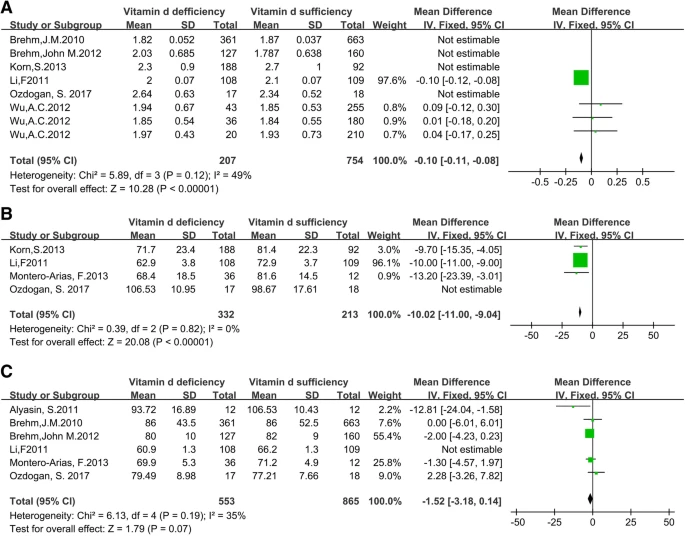Respiratory Research
Research – Open Access
Jian Liu, Yong-Quan Dong, Jie Yin, Jian Yao, Jie Shen, Guo-Jie Sheng, Kun Li, Hai-Feng Lv,
Abstract
Background
There is growing literature suggesting a link between vitamin D and asthma lung function, but the results from systematic reviews are conflicting. We conducted this meta-analysis to investigate the relation between serum vitamin D and lung function in asthma patients.
Methods
Major databases, including OVID, MEDLINE, Web of Science and PUBMED, were searched until 10th October 2018. All published observational studies related to vitamin D and asthma were extracted. All meta-analyses were performed using Review Manager 5.3.5.
Results

This quantitative synthesis found that asthma patients with low vitamin D levels had lower forced expiratory volume In 1 s (FEV1) (mean difference (MD) = − 0.1, 95% CI = − 0.11 to − 0.08,p < 0.01;I2 = 49%, p = 0.12) and FEV1% (MD = − 10.02, 95% CI = − 11 to − 9.04, p < 0.01; I2 = 0%, p = 0.82) than those with sufficient vitamin D levels. A positive relation was found between vitamin D and FEV1 (r = 0.12, 95% CI = 0.04 to 0.2, p = 0.003; I2 = 59%,p = 0.01), FEV1% (r = 0.19, 95% CI = 0.13 to 0.26, p < 0.001; I2 = 42%, p = 0.11), forced vital capacity (FVC) (r = 0.17, 95% CI = 0.00 to 0.34, p = 0.05; I2 = 60%, p = 0.04), FEV1/FVC (r = 0.4, 95% CI = 0.3 to 0.51, p < 0.001; I2 = 48%, p = 0.07), and the asthma control test (ACT) (r = 0.33, 95% CI = 0.2 to 0.47, p < 0.001; I2 = 0%, p = 0.7). Subgroup analysis indicated that the positive correlation between vitamin D and lung function remained significant in both children and adults.
Conclusions
Our meta-analysis suggested that serum vitamin D levels may be positively correlated with lung function in asthma patients. Future comprehensive studies are required to confirm these relations and to elucidate potential mechanisms.
